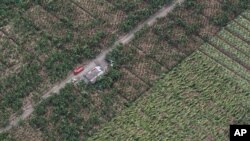MANILA —
In typhoon-hit parts of the central Philippines, there is a race to get crops planted. Officials say fast-harvest crops are critical for survivors' food needs once relief aid runs out. Typhoon Haiyan has so far killed more than 6,000 people and left about 1,800 missing.
The latest government figures put damage to farmland in the affected central provinces at almost $395 million. In the hardest hit areas people rely on subsistence farming and fishing to get by. And agriculture officials say planting has begun even while some areas are still being cleared of storm debris.
“Our main objective now is food first," explained Dante Delima, an undersecretary and national rice program coordinator with the Philippines Department of Agriculture.
"So we must plant plants that can provide, as soon as possible, food for the communities. So that after these relief efforts from international donors and the government, communities can stand [by] themselves and they cannot feel that there’s hunger in the community,” Delima said.
While some seeds have already been planted, government and aid agencies continue to procure seeds for fast growing crops such as rice, white corn, cassava and mung beans, Delima said.
The Social Welfare and Development Department, which has been overseeing emergency food relief from government and aid agencies, said it will stop emergency food assistance by December 31, when it will transition to other aid such as “food for work” schemes.
One of the crops with crucial timing is rice.
In the hardest hit provinces of Leyte and Samar, rice is ready for harvest in October and November. Then, new seeds are planted at the end of December and those are harvested in March through April. Officials said while most of the October-November crop was harvested before typhoon Haiyan ravaged the region, many rice storehouses lost their roofs in the storm.
United Nations Food and Agriculture Organization’s Philippine Representative Rodrigue Vinet said farmers need to plant 63,000 hectares of rice.
“The challenge is, first of all, to make sure those families are actually able to rebuild their home and then get into their field and clean their land. For a farmer it’s key for them as a priority, as soon as they can, to plant their field again because that secures the harvest,” stated Vinet.
Vinet said with each hectare yielding about two tons of rice, the replanted area could effectively produce enough to feed 1.1 million people for a year.
Delima said coconut crops are also a big concern in the region. He said with the Philippines being a major exporter of coconut products, this is the most economically viable produce in the affected area.
Delima said 440,000 hectares of coconut land needs rehabilitation. He said the fallen trees are providing wood for rebuilding, but there is not enough manpower and too few tools such as chainsaws to do the job. It takes about four years for a coconut tree to mature. Delima said the Agriculture Department is looking at varieties that grow in less time.
The latest government figures put damage to farmland in the affected central provinces at almost $395 million. In the hardest hit areas people rely on subsistence farming and fishing to get by. And agriculture officials say planting has begun even while some areas are still being cleared of storm debris.
“Our main objective now is food first," explained Dante Delima, an undersecretary and national rice program coordinator with the Philippines Department of Agriculture.
"So we must plant plants that can provide, as soon as possible, food for the communities. So that after these relief efforts from international donors and the government, communities can stand [by] themselves and they cannot feel that there’s hunger in the community,” Delima said.
While some seeds have already been planted, government and aid agencies continue to procure seeds for fast growing crops such as rice, white corn, cassava and mung beans, Delima said.
The Social Welfare and Development Department, which has been overseeing emergency food relief from government and aid agencies, said it will stop emergency food assistance by December 31, when it will transition to other aid such as “food for work” schemes.
One of the crops with crucial timing is rice.
In the hardest hit provinces of Leyte and Samar, rice is ready for harvest in October and November. Then, new seeds are planted at the end of December and those are harvested in March through April. Officials said while most of the October-November crop was harvested before typhoon Haiyan ravaged the region, many rice storehouses lost their roofs in the storm.
United Nations Food and Agriculture Organization’s Philippine Representative Rodrigue Vinet said farmers need to plant 63,000 hectares of rice.
“The challenge is, first of all, to make sure those families are actually able to rebuild their home and then get into their field and clean their land. For a farmer it’s key for them as a priority, as soon as they can, to plant their field again because that secures the harvest,” stated Vinet.
Vinet said with each hectare yielding about two tons of rice, the replanted area could effectively produce enough to feed 1.1 million people for a year.
Delima said coconut crops are also a big concern in the region. He said with the Philippines being a major exporter of coconut products, this is the most economically viable produce in the affected area.
Delima said 440,000 hectares of coconut land needs rehabilitation. He said the fallen trees are providing wood for rebuilding, but there is not enough manpower and too few tools such as chainsaws to do the job. It takes about four years for a coconut tree to mature. Delima said the Agriculture Department is looking at varieties that grow in less time.






